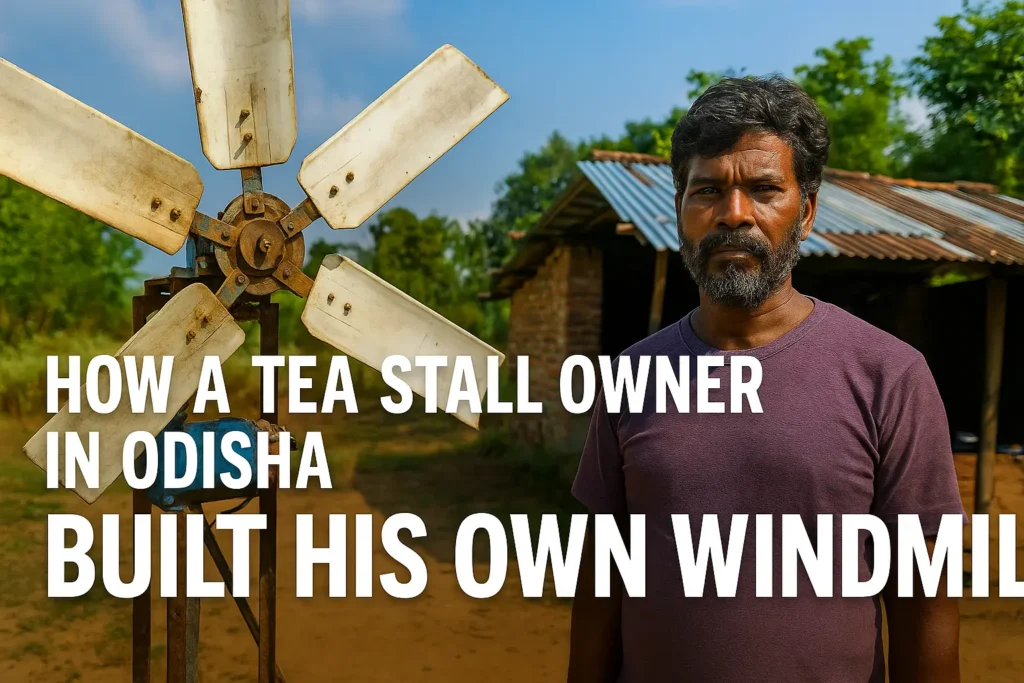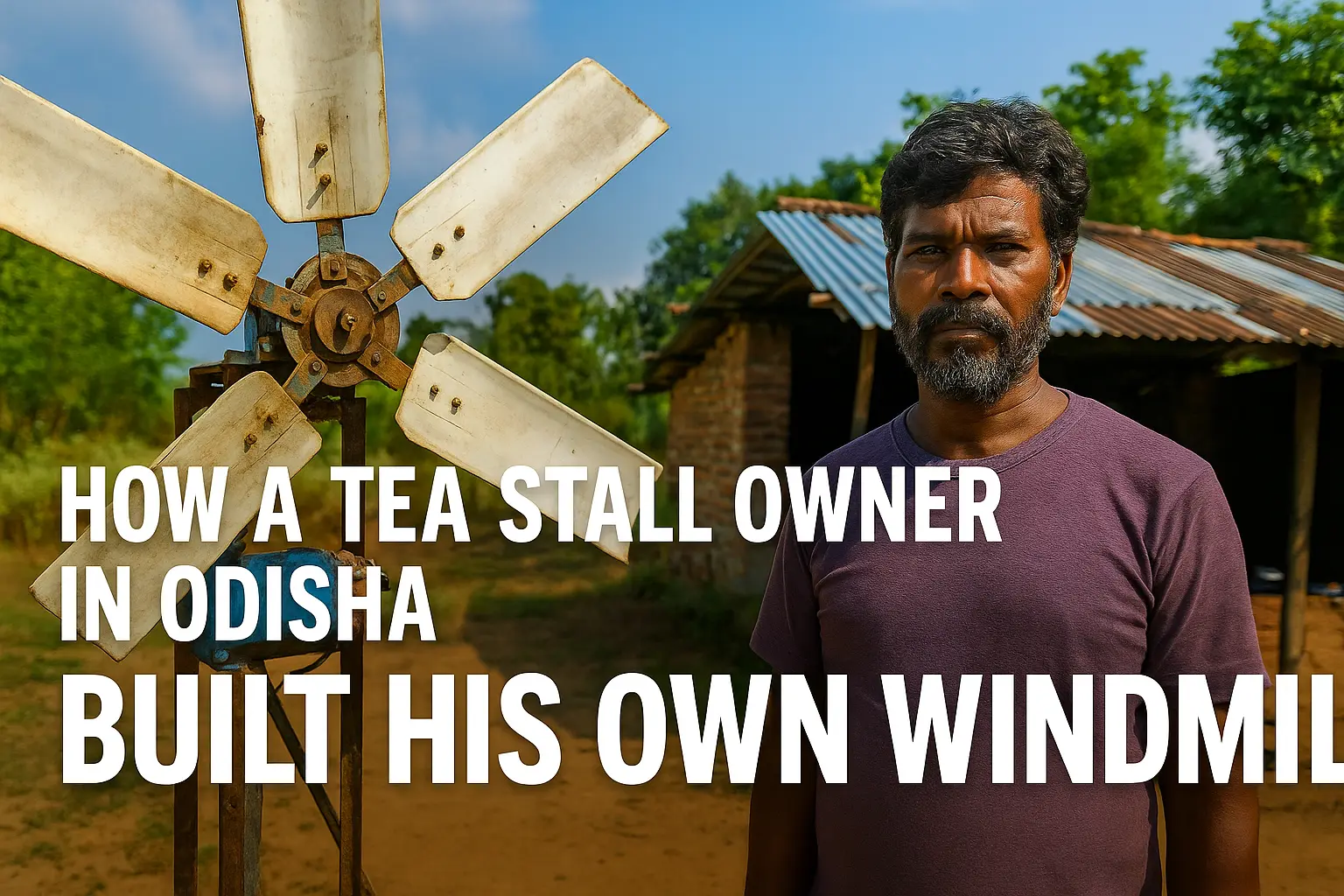Innovation is not always born in laboratories, tech parks, or elite institutions. Sometimes, it comes from the most unexpected corners of rural India, shaped by necessity, ambition, and a stubborn refusal to give up. One such inspiring story unfolds in a small town in Odisha, where a humble tea stall owner built his very own windmill using scrap materials, a few tools, and a vision to generate clean energy for his home and business.
This is the story of resilience and resourcefulness—a tale that shows how one person’s determination can overcome financial constraints and lack of formal education to make a real difference, both for himself and for those around him.
Life Before the Windmill
Ramesh (name changed for privacy), a tea seller in the outskirts of Balasore, Odisha, ran a modest stall on the side of a busy road. Like many in his position, he lived hand to mouth, serving customers from early morning till late at night. The income barely covered daily expenses, let alone luxuries like reliable electricity.
Power cuts were frequent in his village. On some days, electricity would be gone for hours, especially during the summer. Ramesh would struggle to light his stall at night or operate a small fan during peak heat. His children would study by kerosene lamp, and he often relied on candles and flashlights to get by.
Instead of resigning himself to this fate, Ramesh began exploring alternatives. He had heard of wind energy in school and later saw a documentary on it while watching television at a nearby shop. The concept stayed with him.
The Spark of an Idea
Ramesh was no engineer, but he had always been curious. He repaired his own tools, knew basic wiring, and occasionally helped neighbors fix appliances. One day, while watching plastic bags flutter on a clothesline in strong wind, the idea came back to him—why not try building a windmill?
The thought sounded absurd to many around him. After all, windmills were expensive structures built by companies or governments, not something a tea stall owner could create. But Ramesh was determined. If he could build even a small windmill to power a few lights and a fan, it would make a huge difference.

Building the Windmill from Scratch
Ramesh didn’t have money to buy components. What he did have was time, patience, and the ability to collect scrap. He visited local junkyards, workshops, and abandoned buildings, asking for broken appliances, discarded machinery, and leftover materials.
Here’s how he pieced together his windmill:
- Blades: He cut the blades from old PVC pipes. He shaped them using a heated knife and smoothed the edges with sandpaper. These were mounted symmetrically to ensure balance.
- Motor: He repurposed a small DC motor from a broken washing machine. This motor, when rotated by wind, could generate electricity.
- Tower: A tall bamboo pole supported the windmill. He secured it firmly into the ground with concrete, ensuring stability even in heavy winds.
- Hub and Bearings: Used cycle parts helped mount the blades and allow free rotation. He added ball bearings from a damaged scooter wheel to reduce friction.
- Battery and Wiring: Old inverter batteries were sourced and repaired to store energy. Basic copper wires, switches, and fuses completed the circuit.
It took him three months of effort, mostly working late at night or during slow hours at the stall. He learned by watching YouTube videos at a friend’s phone shop and asking questions to local electricians and mechanics.
A Functional Windmill at Last
The day he installed the windmill was unforgettable. With no fanfare and no formal training, Ramesh raised his 12-foot tower beside his home. The blades spun slowly at first, then picked up speed as wind picked up. To his delight, the battery began charging.
By nightfall, the windmill had generated enough power to light three LED bulbs and power a small table fan for a few hours. It wasn’t much by urban standards, but for Ramesh, it was revolutionary.
Over time, he made improvements. He added a charge controller to avoid battery overcharging. He also mounted a small indicator LED to show when the battery was full. Eventually, he was able to power his stall lights, a mobile charging station, and even a small radio—all from the wind.
Local Recognition and Inspiration
News of Ramesh’s windmill spread quickly in the area. Passersby who stopped at his stall would marvel at the spinning blades. Students, local teachers, and NGO workers visited to learn more. His effort was even recognized by a local government school, which invited him to speak during a science awareness event.
Ramesh had never spoken in front of a crowd before, but he took the opportunity with pride. He explained how he had built the windmill and why such simple innovations could improve lives. His message was clear: you don’t need big money or degrees to solve problems—just curiosity, creativity, and the will to act.
Why Grassroots Innovation Matters
Ramesh’s story is not just about a single windmill. It’s part of a larger pattern seen across rural India, where individuals, often with little formal education, are coming up with ingenious solutions to local challenges. These stories rarely make headlines, but they are transforming lives at the grassroots level.
His windmill is an example of frugal innovation—creating affordable, functional technology with limited resources. In a country where millions still lack reliable electricity, such low-cost models can inspire communities to explore alternative solutions.
Moreover, it highlights the importance of practical knowledge-sharing. If local governments, schools, and NGOs can support individuals like Ramesh by documenting and spreading their ideas, the impact could be immense.
Potential for Expansion and Replication
Since building his windmill, Ramesh has expressed interest in helping others do the same. With basic training and a small toolkit, he believes any village youth could replicate or improve upon his design.
Here are some ideas to scale such grassroots efforts:
- Training Workshops: Local organizations can conduct hands-on sessions in schools or community centers.
- Documentation: Simple manuals in local languages can help others follow the same steps.
- Microfunding: Small grants or toolkits can support innovators with limited means.
- Mentorship Programs: Linking innovators with engineering students or institutions can improve designs and expand applications.
Final Thoughts
In a world overwhelmed by high-tech gadgets and million-dollar solutions, stories like Ramesh’s windmill remind us of a different kind of power—the power of individual resolve, homegrown innovation, and the desire to bring light into one’s life, quite literally.
The tea stall in Odisha now does more than just serve hot beverages. It’s a symbol of what’s possible when someone looks at the wind not as a challenge to endure, but as a resource to harness.
